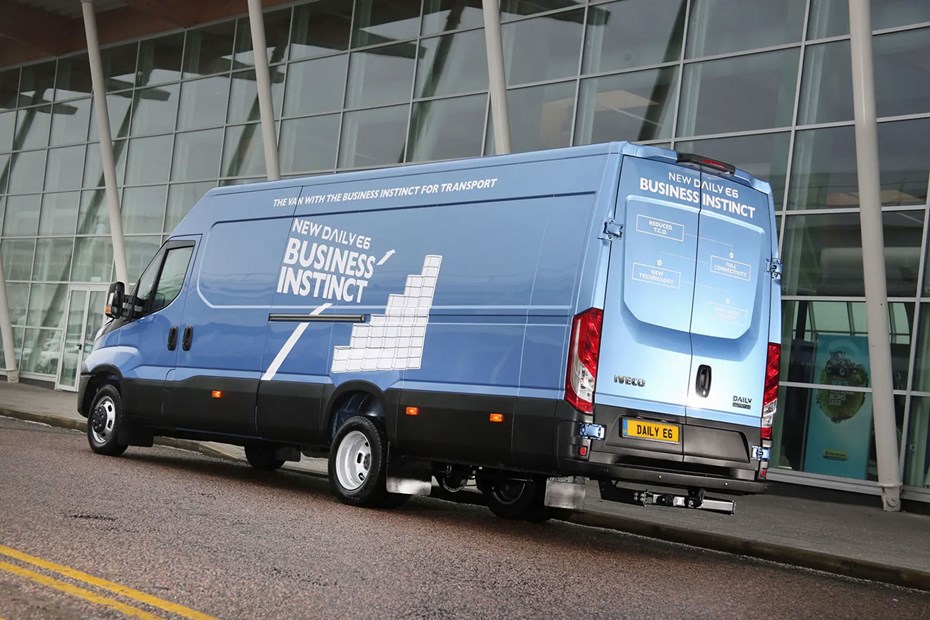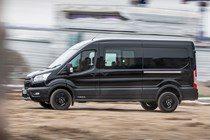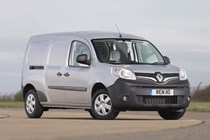If you’re looking for a long-wheelbase van, the chances are you’ve got a lot of stuff to shift. But there’s more to moving mass than the sheer size of the vehicle, so join us as we run you through the pros and cons of LWB vans, the kinds of challenges you might face, and even the licence, tax and regulation issues.
Almost every van on sale is available as a long-wheelbase model (you might see it written as long wheel base van) – referring to the distance between the front and rear wheels – but to many people the term simply means a particularly large panel van.
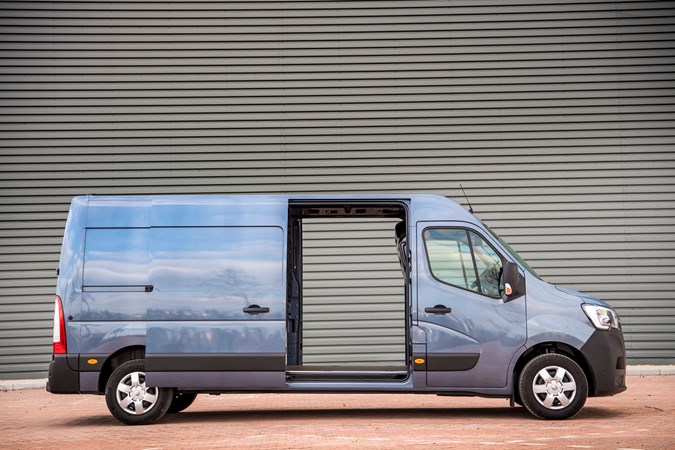
Large van models that usually spring to mind are the Ford Transit and the Mercedes-Benz Sprinter, but even these come in different sizes, all of which are bigger than a typical medium van such as the Ford Transit Custom or Volkswagen Transporter.
Understanding this is important, because the bigger the van, the more it weighs – which can in turn reduce the amount of payload you are able to carry in the back. Depending on the type of business you do, the amount of payload may be more important than the size of the load area.
Different types of long-wheelbase van
There are three main van categories: small, medium and large. All of these are available as ordinary or short-wheelbase (SWB) vans and long-wheelbase (LWB) vans. Sometimes the longest are referred to as extra-long wheelbase vans, but this is just a way of referring to the longest model in a range.
Small vans, such as the Ford Transit Connect and Citroen Berlingo, are ideal for city driving because they’re nimble and easy to park almost anywhere. And while the long-wheelbase models are bigger on the outside than a large estate car, they are handy if you need a little extra load space, perhaps for a couple of Euro pallets.
Often LWB small vans are called maxi vans – take the Volkswagen Caddy Maxi and the previous Renault Kangoo Maxi, for example.
Medium vans offer a larger load space and greater driving refinement than small vans, but they are still easy to drive in tight spaces and shouldn’t be too difficult to park.
Popular long-wheelbase medium vans include the Ford Transit Custom L2 and the Vauxhall Vivaro L2. Though if you’re looking for a lengthy load space from a medium-size panel van, the Renault Trafic LWB is a great place to start, as it has a particularly long cargo area for its size. Plenty of medium vans offer a little more storage through the use of a through-load bulkhead that lets you slot long, thin items under the front seats.
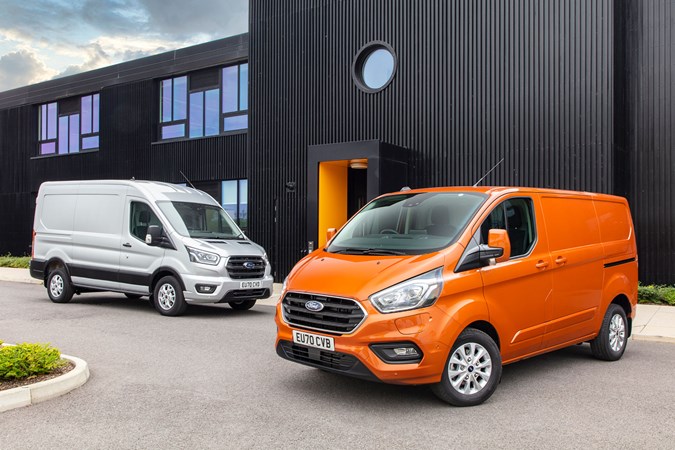
As for large vans, such as the Ford Transit, Mercedes Sprinter, Peugeot Boxer and Renault Master, all of these are available in at least two wheelbase lengths, with the largest long-wheelbase van dimensions being found among this category.
As we’ve already mentioned, even the smallest versions of these have lots of cargo space. The largest versions will also typically be the clumsiest to handle in busy towns, and won’t fit in many ordinary car parks – though many modern large vans, including the multiple Parkers Award-winning Volkswagen Crafter and MAN TGE are now very easy and pleasant to drive.
Long-wheelbase van payload ratings
The thing about going for a long-wheelbase van is that you’ll usually find their payload ratings are lower than on short-wheelbase versions of the same model. The term payload refers to the weight of a van is carrying, including the people.
The larger the van, the more it weighs before you’ve loaded anything into it. So if the maximum authorised mass (MAM – more on this below) is fixed, a smaller version of the same van will actually have a higher payload rating because the van itself is lighter.
Whether this matters comes down to what you’re carrying. If it’s bulky but not particularly heavy you obviously want the biggest van possible. But if weight is a factor you may want to stick to a short-wheelbase model rather than go for the biggest van in the range.
Here are some examples of what we mean, showing the payload comparison and the difference in load space capacity (volume) between SWB and LWB versions of the same van:
| Standard size | Long-wheelbase | Difference | |
| Ford Transit | L2 H3 RWD | L4 H3 RWD | |
| Wheelbase | 3,300mm | 3,750mm | 450mm |
| Overall length | 5,531mm | 6,704mm | 1,173mm |
| Payload | 1,277-1,342kg | 1,110-1,176kg | 117-166kg |
| Load volume | 10.7 cubic metres | 15.1 cubic metres | 4.4 cu m |
| VW Transporter | T32 110hp SWB | T32 110hp LWB | |
| Wheelbase | 3,000mm | 3,400mm | 400mm |
| Overall length | 4,904mm | 5,304mm | 400mm |
| Payload | 1,304kg | 1,240kg | 64kg |
| Load volume | 5.8 cubic metres | 6.7 cubic metres | 0.9 cu m |
| Peugeot Partner | Standard (MWB) | Long (LWB) | |
| Wheelbase | 2,785mm | 2,975mm | 190mm |
| Overall length | 4,403mm | 4,753mm | 350mm |
| Payload | 803-1,000kg | 751-974kg | 12-52kg |
| Load volume | 3.3 cubic metres | 3.8 cubic metres | 0.5 cu m |
>> Best large vans for payload
>> Best medium vans for payload
>> Best small vans for payload
Long-wheelbase van gross vehicle weight
Gross vehicle weight (GVW) is the same as maximum authorised mass (MAM), gross vehicle mass (GVM) and a host of other terms that all mean the same thing – and means the total legally allowed weight of the van and everything inside it. Including not just the goods, but the people.
This is different to the payload, which is the weight of everything on board but does not include the weight of the van.
When it comes to small and medium vans, gross vehicle weight can be flexed a bit by the manufacturer – so a long-wheelbase medium van might be given a higher maximum authorised mass than the short-wheelbase version, in order to maintain the same payload rating.

This isn’t quite as straightforward for large vans, because most of these have a gross vehicle weight of 3,500kg – the highest GVW you’re allowed to drive on a regular car driving licence.
There are large vans with higher (and lower) gross vehicle weights, the most extreme example being the Iveco Daily, which goes up to 7,000kg.
Nearly every large van manufacturer offers at least some increased GVW variants, however; one of the newest is the Ford Transit 5.0-tonne (5,000kg).
If you passed your test before 1 January 1997, you can drive these heavy-hauling vans no problem. But if you passed after this date then you need a different kind of licence (see the FAQ section below for more info).
The only exception to this is for alternative-fuel vehicles such as large electric vans, which have a special exemption allowing up to 4,250kg GVW on a standard driving licence no matter when you passed the test.
Long-wheelbase van hire
Whether you need to complete a one-off journey – to collect something or perhaps to move house – or need a longer-term loan in order to support your business, there are plenty of firms around that will allow you to hire or lease a long-wheelbase van.
As long as the maximum authorised mass isn’t over 3,500kg you won’t need any special driving licence to do this.
Prices vary, so the best advice is – as always – to shop around.
A business lease on a long-wheelbase van may prove very cost-effective versus other forms of finance, but keep in mind that you won’t have the option to own the vehicle at the end of the contract – and that damage charges can get expensive upon the van’s return if you aren’t reasonably careful.
Long-wheelbase van problems
Aside from the potential payload issue we’ve covered above, if you’re trying to decide between a short-wheelbase van and a long-wheelbase van, you also need to think about the obvious issue: size.
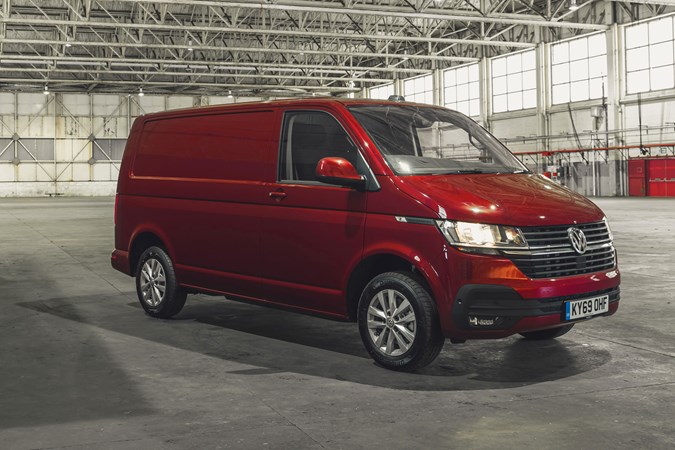
If you’ve always got big goods to shift, you may not have a choice. But consider, the larger the van, the more difficult it will be to park, and it will be trickier to move around in tight spaces and corners.
If you’re looking at a Ford Transit long-wheelbase large van or similar, you’re probably well-prepared for this. But if you’re considering a medium van such as the Ford Transit Custom or VW Transporter, then you may be expecting to access ordinary car parks, something that won’t always be as easy in the longer model compared with the shorter version.
This will be less of an issue for small vans, which should be easy to manoeuvre whether you go for the standard or maxi model.
Long-wheelbase campervans
Medium vans are often used as the basis for campervan conversions, and here also you need to carefully consider the advantages of space that a long-wheelbase model will bring compared with the disadvantages of it not being so easy to park.
This probably explains why only Ford makes a medium-sized, factory-backed campervan with a long-wheelbase campervan, the L2 version of the Transit Custom Nugget. The rival Volkswagen California and Mercedes Marco Polo only come as short-wheelbase vans.
>> The Parkers guide to factory-backed campervans
It’s a similar issue with campervan and motorhome conversions on large vans, though here you also run into a maximum authorised mass issue, which may mean you end up needing a different driving licence for a large LWB camper.
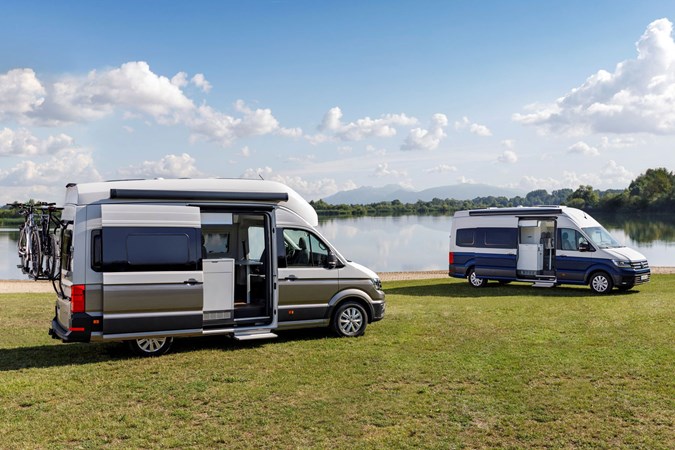
Volkswagen, for example, offers higher gross vehicle weight versions of the Grand California that require a C1 licence classification.
Long-wheelbase van FAQs
What does wheelbase mean on a van?
The term ‘wheelbase’ refers to the distance between the centre point of the front and rear wheels (or axles). A long-wheelbase van is one that has a longer distance between these two points than the ordinary – or short-wheelbase – version.
The two terms are often abbreviated to LWB for long-wheelbase van and SWB for short-wheelbase van, making it easy to identify different models in brochures and vans for sale adverts. Other common identifying terms are L1 and L2, though this can also refer to the length of the van’s body.
Usually when people think of a long-wheelbase or LWB van, however, they’re thinking of something particularly big – such as so-called ‘jumbo’ long-wheelbase Transit vans, which have both a long-wheelbase and a massive load area.
What does payload mean on a van?
This is the amount you’re legally allowed to carry – including the people. Every van on sale has a specific payload rating, recorded on the weight plate (which is usually found under the bonnet).
Are there vans with more than two wheelbase sizes?
Yes. Quite a few large panel vans have more than two wheelbase sizes, necessary because of the supersize bodywork that they can be equipped with. For the same reason you’ll find there are multiple body lengths, usually referred to by L numbers that confusingly don’t always start at L1…
You’ll often find the very biggest models described as super-long wheelbase vans or extra-long wheelbase vans – or as in the case of the biggest long-wheelbase Transit, jumbo vans.
What driving licence do I need for a long-wheelbase van?
As long as the maximum authorised mass / gross vehicle weight isn’t higher than 3,500kg – or 3.5-tonnes, as it’s sometimes written as – you can drive any long-wheelbase van on a regular UK car driving licence. This is officially known as a Category B licence.
If the van in question has a MAM greater than 3,500kg, you need what’s known as a Category C1 licence, a goods vehicle licence covering vans and other commercial vehicles with a MAM from 3,500kg to 7,500kg.
If you passed your driving test before 1 January 1997 you were automatically granted a C1 licence, but if you passed after this date you will need to apply for a C1 provisional licence, then take a theory and practical test in order to get one.
The minimum age is 18, and there’s a higher medical standard to meet as well. You can find out more on the UK driving licence categories website.
If you drive a C1 licence vehicle professionally – so for business or work purposes – you also need a Driver CPC Qualification, the Driver Certificate of Professional Competence.
The exception to this is if the long-wheelbase van is electric. If it is then you could drive one weighing up to 4,250kg on a standard licence. You will need to do some extra training, but
How much does long-wheelbase van tax cost?
Under the current fixed-rate taxation levels for light good vehicles (up to 3,500kg MAM), all vans cost exactly the same in road tax (VED) and company van tax (benefit-in-kind / BIK).
So there is no tax penalty for going for a bigger model unless it’s over the 3,500kg threshold. You can read more about this in our van tax guide.
What are long-wheelbase van speed limits?
Vans are subject to different speed limits to cars, and you find out more in our van speed limit guide.



